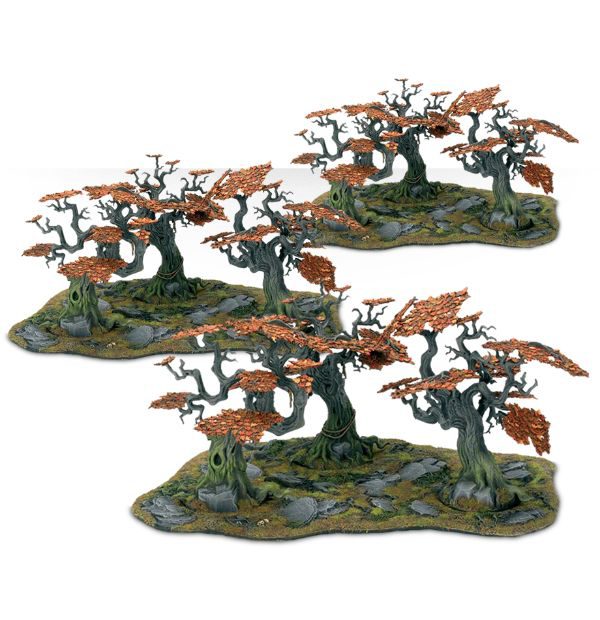[podbean resource=”episode=kmnp5-6d4736″ type=”audio-rectangle” height=”100″ skin=”1″ btn-skin=”107″ share=”1″ fonts=”Helvetica” auto=”0″ download=”0″ rtl=”0″]
Effective deployment is fundamental to success at Warhammer: Age of Sigmar. While good deployment will not win you a game, poor deployment can leave your key units exposed, your key threats neutered and you quickly behind on the scenario. So how do you deploy well?
There are so many variables involved in deployment – there are no guaranteed answers. All you can do is have a plan to put yourself in the best position, and then adapt accordingly. Therefore, in this episode I’ll give you a methodology for approaching deployment.
- Deployment and set-up: the rules
- Which side to choose?
- Why finishing deployment first matters
- Consider deployment in list design
- Battalions and deployment
- In which order should you deploy your units?
- Where to place your units?
- Deployment off the table
- Take the first or second turn?
- Conclusion
- Further resources
Deployment and set-up: the rules
Let’s start with the rules for deployment. Each player rolls a dice. The winner chooses territory and will start deploying first. Players then alternate setting up units until all units are set-up. The players that finishes setting up first always chooses who takes the first turn.
A unit is set-up even if it is not placed on the table-top but is instead deployed in a location other than the battlefield – for example, in the spirit paths, tunnels, clouds etc.
The scenarios will tell you where to set up and if there are any limits (for example, Escalation). As a minimum, all units are at least 12″ from enemy territory. Note that the FAQ has changed the deployment zones for Escalation – you can find a replacement deployment map made by @golongdesign in the resources section here.
Which side to choose?
If you win the roll off, you get to choose the side. While you may be tempted to just stay with the side of the table you are standing on, just because you can’t be bothered moving your army or squeezing through long rows of gamers, it is worth deciding.
What should you take into account? Assess where the mysterious terrain is on the board and the objectives for the scenario. For the mysterious terrain, what would help your army? Arcane for spellcasters, mystical or damned for a combat unit? What would benefit your opponent – i.e. can you deprive them of a piece of scenery that would give them a significant advantage.
The Double Turn – why choosing the first turn matters
Finishing deploying first is important because you get to choose who takes the first turn. If you make your opponent take the first turn, then you have a chance of winning the priority roll at the end of first turn and getting a double turn early. By getting the first double turn, you can dictate the early development of the game, swarm over objectives and neuter your opponent’s key pieces before they even really get started. There are a couple of situations where you may consider taking the first turn and I’ll return to them later.
Consider deployment in list design
So you need to take deployment into account in your list design. You need to think about the number of deployments, or “drops”, in your army. So why have I said “drops” rather than units? Because there are particular rules for battalions which mean you can deploy more than one unit at once.
Battalions and deployment
Units in battalions can be deployed in three ways:
- All at once (rather than unit by unit)
- Some units, and then the remaining units individually
- Unit by unit
If you choose to deploy the entire battalion at the same time, you can choose to deploy some of those units in a location other than on the table if they have that option available.
What you can’t do, however, is start dropping units individually from a battalion and then try to drop all the remaining units from the battalion in one go. Once you start dropping a battalion’s units individually, you have to keep doing so.
If you are wondering where these rules are, they are tucked away in the hints and tips section of battletomes. So if you don’t have a battletome, it is understandable that you might have missed it. It is also worth checking the FAQs regarding “set-up”.
Some of the “super-battalions”, such as the Sylvaneth wargroves, give you the ability to deploy your entire army in one go. While a one drop deployment will ensure you pick who gets the first turn (depending on the dice roll to set-up first) it also means that you deploy blind and lose the ability to react to your opponent’s deployment.
Most one drop armies, are made up of several battalions within a “super-battalion”. Therefore, it is possible for these armies to deploy in one go, say 4 drops, 7 drops, or drop all units individually. It is worth thinking through the permutations. If you know you can drop in 7 drops, and still finish before your opponent, drip feed your units so you don’t show your hand too early, can react, but still get choice of first turn.
You should always ask your opponent the minimum number of drops they could deploy in – with super battalions, there might be a number of answers to that question. Could drop all, drop one battalion and dip rest etc.
In which order should you deploy your units?
The order that you deploy your units in is important.
Start with your least important or highly mobile pieces, so should your opponent deploy on the other side of the board, you won’t miss the unit or the unit can redeploy quickly.
Leave your best or most vulnerable pieces until last until your opponent’s threats have been deployed.
It is more difficult to decide when to drop your buff pieces. If you drop them early, you can make sure that all the following units deployed will be in range of the benefit. However, the trade-off is that your opponent will know where most of your forces are going to be.
Where to place your units?
There are a number of things to take into account when deciding where to place your units.
Threat range
What is the threat range of your units and your opponent’s units? Threat range is a combination of movement and damage range (magic / shooting / charge and reach).
Threat range needs to be considered in conjunction with the potential damage output of your opponent’s units. The benefits of deploying within threat range may outweigh the small amount of damage that might be inflicted.
Scenario
Of all the GHB scenarios, only Border War and Three Places of Power have objectives relevant to the first round (in that they can be captured and scored). When deciding whether to seize those objectives, make sure you can hold them – why rush if that then means your unit is easily in charge range? Do you want to push past and then retreat back onto the objective?
Forecast where the major battles will be – where are the objectives? Where are the gaps in the terrain? Where will their army be after the first turn?
Protect your key pieces – layers of deployment
It is important to deploy in a way that protects you from your opponent’s threats, especially if you are giving them the first turn. This often involves “bubble-wrapping” or protecting your key units with less valuable units. For instance, placing your low-value units in a ring at a distance so that your opponent cannot pop up some tunnelling stormfiends within shooting distance of your key pieces.
When doing so, try to consider whether you are blocking up your key combat pieces should the opponent engage your bubble-wrapping units in combat.
Therefore, you will often find yourself deploying in layers – starting with chaff units, your counter-punch units, support characters and then bows/artillery in the middle.
Synergies
As you deploy, check your support bubbles – is everything in range of buffs you need?
What if you can’t dictate first turn?
If you can’t choose who takes the first turn, how should you deploy? All you can do is make the most of the situation. Threaten key pieces by being aggressive yourself. Make your opponent question whether to take the first turn.
You want to pose questions of your opponent. The more decisions you make them take the more likely they are to make an error.
Deployment off the table
In Age of Sigmar, a number of armies have the ability to deploy units or entire battalions in locations other than the table top or in your deployment zone. These include:
- Sylvaneth, deploying in the trees
- Overlords from the sky
- Stormcast
- Skaven in the tunnels
- Fyreslayers, tunnelling underground
- Gutter runners
- Shadow warriors
- Night runners
- Changeling
- Battalions – Ghoul Patrol, Wanderers, Winterleaf (can deploy through an Ophidian Archway)
Its also worth noting that some armies can summon units on to the board in the first turn, effectively gaining the ability to deploy units outside the usual deployment zone. Summoning will be covered by a separate episode.
So what do you need to know about alternative deployments?
Most of these rules allow you to bring units on at your choice in one of your movement phases. This will mean that for most of these units, they will have missed the hero phase, usually won’t get the benefit of command abilities or spells, and count as having moved so cannot move again.
Also, most of these units will be required to be deployed outside of 9″ of your units. This means that these units would have a 27.8% chance of making a successful charge under usual conditions.
The 9″ rule also means that you can deny your opponent the table space required by these abilities by making sure there are no ‘pockets’ of the battlefield more than 9″ away from any of your models. For example, position models in the centre of wyldwoods if facing Sylvaneth etc. So if take second turn, the risk is you wont be able to get units on the board in the best places.
As I’ve mentioned, if you deploy your armies in layers, it means your important pieces are even further away from the enemy units which have just popped up but you have units which can counter-charge within easy reach.
Do you take the first or second turn?
As I’ve said, in most circumstances you will want to give your opponent the first turn. Most armies don’t have the reach to do anything effective on the first turn (armies are 24″ apart). By reach, I mean the ability to move and attack to influence the game.
Also, if you have deployed models off the table, then there is little point in taking the first turn. If you deploy those reserved models in the first turn, then you will normally not have any defensive buffs up for if your opponent gets a double turn from battleround 1 into 2.
You may want to take the first turn if you are able to survive the initial double turn, and you want the double turn going into the third battleround. For instance, in Blood and Glory if you control all four objectives, starting from the third battleround, you get a major victory.
Other things to take into account are: Can you capture an objective without overextending? Can you neuter their key units on first turn? Do you need to use your command abilities to survive the first turn? Do you need to risk it (i.e. are you so outmatched unless you can do something unexpected?)
Conclusion
Deployment is the game within the game of Warhammer: Age of Sigmar. Learn to do it well and you will set yourself up for more victories.








